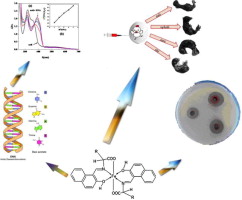In this study, new Fe(II) Schiff base amino acid chelates derived from the condensation of o-hydroxynaphthaldehyde with l-alanine, l-phenylalanine, l-aspartic acid, l-histidine and l-arginine were synthesized and characterized via elemental, thermogravimetric analysis, molar conductance, IR, electronic, mass spectra and magnetic moment measurements. The stoichiometry and the stability constants of the complexes were determined spectrophotometrically. Correlation of all spectroscopic data suggested that Schiff bases ligands exhibited tridentate with ONO sites coordinating to the metal ions via protonated phenolic-OH, azomethine-N and carboxylate-O with the general formulae [Fe(HL)2]·nH2O. But in case of l-histidine, the ligand acts as tetradentate via deprotonated phenolic-OH, azomethine-N, carboxylate-O and N-imidazole ring ([FeL(H2O)2]·2H2O), where HL = mono anion and L = dianion of the ligand. The structure of the prepared complexes is suggested to be octahedral. The prepared complexes were tested for their teratogenicity on chick embryos and found to be safe until a concentration of 100 μg/egg with full embryos formation. Moreover, the interaction between CT-DNA and the investigated complexes were followed by spectrophotometric and viscosity measurements. It was found that, the prepared complexes bind to DNA via classical intercalative mode and showed a different DNA activity with the sequence: nhi > nari > nali > nasi > nphali. Furthermore, the free ligands and their complexes are screened for their in vitro antibacterial and antifungal activity against three types of bacteria, Escherichia coli, Pseudomonas aeruginosa and Bacillus cereus and three types of anti fungal cultures, Penicillium purpurogenium, Aspergillus flavus and Trichotheium rosium in order to assess their antimicrobial potential. The results show that the metal complexes are more reactive with respect to their corresponding Schiff base amino acid ligands.


